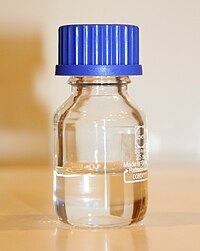
Photo from wikipedia
Abstract Two metal–organic frameworks based on a multifunctional ligand 2-(5-bromo-pyridin-3-yl)-1H-imidazole-4,5-dicarboxylic acid (H3L), [Mn(HL)(C2H5OH)]n (1) and {[Zn(HL)(H2O)2]·H2O}n (2), have been hydro/solvothermally synthesized and characterized by IR, elemental analyses, X-ray powder and… Click to show full abstract
Abstract Two metal–organic frameworks based on a multifunctional ligand 2-(5-bromo-pyridin-3-yl)-1H-imidazole-4,5-dicarboxylic acid (H3L), [Mn(HL)(C2H5OH)]n (1) and {[Zn(HL)(H2O)2]·H2O}n (2), have been hydro/solvothermally synthesized and characterized by IR, elemental analyses, X-ray powder and single-crystal diffractions, and thermogravimetric analyses. In 1, (HL)2– ligands adopt the μ3-kN,O:kN′,O′:kN′′ coordination mode and use their imidazoledicarboxylates to bis-chelate MnII into left- and right-handed helixes which are further bridged into a mesolayer structure with (4·82) topology through the coordination of their pyridyl groups. In 2, (HL)2– ligands only use their imidazoledicarboxylates to bis-chelate ZnII into linear chains which are further linked into a 2D supramolecular framework through interchain hydrogen–bonding interactions. Interestingly, the structures of 1 and 2 are mainly dominated by the bis-N,O-chelation of the imidazoledicarboxylate in (HL)2–. As for the formation of the imidazoledicarboxylate-bridged helical chains in 1 or straight chains in 2, it largely depends on the cis- or trans-chelation of two imidazoledicarboxylates around the same metal center. Magnetostructural analysis of 1 discloses that the bis-N,O-chelating imidazoledicarboxylate of (HL)2– transmits antiferromagnetic interactions along the imidazoledicarboxylate-bridged helical chain with the spin-coupling constant of –0.71 cm–1. Additionally, 2 emits greatly enhanced blue fluorescence mainly originating from the intraligand charge transition.
Journal Title: Journal of Coordination Chemistry
Year Published: 2019
Link to full text (if available)
Share on Social Media: Sign Up to like & get
recommendations!